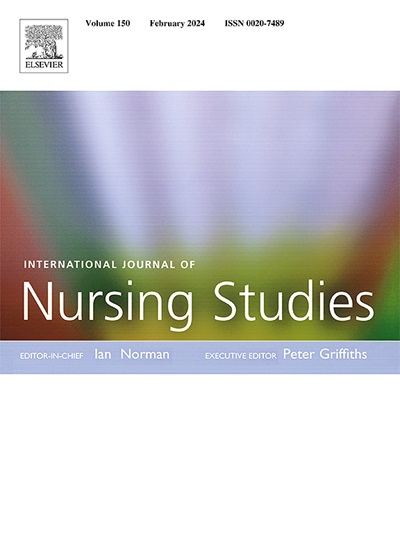妇女孕前教育干预,现状,差距和未来方向:范围综述
IF 7.1
1区 医学
Q1 NURSING
引用次数: 0
摘要
目的总结育龄妇女孕前保健教育干预的研究。方法采用乔安娜布里格斯研究所和Arksey和O'Malley框架进行范围审查。7个电子数据库(PubMed, Embase, CINAHL, ClinicalTrials.gov, Web of Science, Cochrane Database, PsycINFO)从成立到2024年4月19日进行了检索。研究类型包括随机对照试验和非随机对照试验。结果本综述共纳入34篇文献,29项研究(27项随机对照试验)。其中,17项研究(58.6%)针对一般孕前妇女,而其余研究则侧重于特定人群,如体重指数(BMI)较高的妇女、低收入、患有糖尿病的青少年、危险饮酒、人类免疫缺陷病毒(HIV)或吸烟。孕前教育干预主要由卫生保健专业人员提供,涉及多学科团队合作的研究很少。干预措施主要分为两类。面对面教育(24项研究,82.8%)和基于技术的教育(12项研究,41.4%)。六项研究结合了这两种类型,一项研究包括两组使用不同方法的人。面对面教育包括小组会议(16项研究,55.2%)、一对一会议(10项研究,34.5%)和印刷材料(8项研究,27.6%)。基于技术的方法包括网站/聊天机器人(6项研究,17.2%),文本/电话/电子邮件(5项研究,17.2%)和数字材料(2项研究,6.9%)。值得注意的是,16项研究(51.7%)使用了多种教育方法。干预内容涵盖15个主要的孕前健康领域。最常涉及的领域是“健康的生活方式”(22/29,75.9%),但12项研究(41.4%)只涉及单一领域。孕前教育干预对妇女的知识、态度、行为、心理健康和生物特征指标产生了积极影响。然而,关于它们对孕产妇和新生儿结局以及对心理健康和生物特征指标的影响的证据仍然有限。结论孕前教育干预在妇女健康的各个方面都显示出明显的益处。然而,目前的证据揭示了几个关键的差距。加强孕前保健资源的分配和可及性,特别是在低收入和中等收入国家,仍然至关重要。未来的研究应关注高危人群,采取多学科方法,整合综合干预策略。还需要更广泛地覆盖孕前健康领域。此外,对孕产妇和新生儿结局、心理健康和生物特征指标的进一步研究对于加强证据基础和指导实践至关重要。注册本研究方案已在开放科学框架(https://osf.io/6c2dw)注册。本文章由计算机程序翻译,如有差异,请以英文原文为准。
Preconception educational interventions for women, present landscape, gaps, and future directions: A scoping review
Purpose
To summarize studies on educational interventions in preconception care for non-pregnant women of reproductive age.
Methods
A scoping review was conducted using the Joanna Briggs Institute and Arksey and O'Malley frameworks. Seven electronic databases (PubMed, Embase, CINAHL, ClinicalTrials.gov, Web of Science, Cochrane Database, PsycINFO) were searched from inception to April 19, 2024. The study types included randomized controlled trials and non-randomized controlled studies.
Results
A total of 34 articles encompassing 29 studies (27 randomized controlled trials) were included in this review. Among these, 17 studies (58.6 %) targeted general preconception women, while the remaining studies focused on specific populations, such as women with higher body mass index (BMI), low income, teenagers with diabetes, risk drinking, human immunodeficiency virus (HIV), or tobacco use. Preconception educational interventions were predominantly delivered by healthcare professionals, with minimal research involving multidisciplinary team collaboration. The interventions were primarily categorized into two types.
in-person education (24 studies, 82.8 %) and technology-based education (12 studies, 41.4 %). Six studies combined both types, and one study included two groups using different approaches. In-person education included group sessions (16 studies, 55.2 %), one-on-one sessions (10 studies, 34.5 %), and printed materials (8 studies, 27.6 %). Technology-based methods involved websites/chatbots (6 studies, 17.2 %), texts/calls/emails (5 studies, 17.2 %), and digital materials (2 studies, 6.9 %). Notably, 16 studies (51.7 %) used multiple educational methods. The intervention content covered 15 key preconception health domains. The most frequently addressed domain was “healthy lifestyle” (22/29, 75.9 %), but 12 studies (41.4 %) covered only a single domain. Preconception educational interventions demonstrated positive impacts on women's knowledge, attitudes, behaviors, mental health, and biometric indicators. However, evidence on their effects on maternal and neonatal outcomes, as well as on mental health and biometric indicators, remains limited.
Conclusion
Preconception educational interventions have shown clear benefits across various aspects of women's health. However, current evidence reveals several critical gaps. Strengthening the distribution and accessibility of preconception health resources, especially in low- and middle-income countries, remains essential. Future research should focus on high-risk populations, adopt multidisciplinary approaches, and integrate comprehensive intervention strategies. Broader coverage of preconception health domains is also needed. Moreover, further studies on maternal and neonatal outcomes, mental health, and biometric indicators are vital to reinforce the evidence base and guide practice.
Registration
The study protocol was registered in the Open Science Framework (https://osf.io/6c2dw).
求助全文
通过发布文献求助,成功后即可免费获取论文全文。
去求助
来源期刊
CiteScore
15.00
自引率
2.50%
发文量
181
审稿时长
21 days
期刊介绍:
The International Journal of Nursing Studies (IJNS) is a highly respected journal that has been publishing original peer-reviewed articles since 1963. It provides a forum for original research and scholarship about health care delivery, organisation, management, workforce, policy, and research methods relevant to nursing, midwifery, and other health related professions. The journal aims to support evidence informed policy and practice by publishing research, systematic and other scholarly reviews, critical discussion, and commentary of the highest standard. The IJNS is indexed in major databases including PubMed, Medline, Thomson Reuters - Science Citation Index, Scopus, Thomson Reuters - Social Science Citation Index, CINAHL, and the BNI (British Nursing Index).

 求助内容:
求助内容: 应助结果提醒方式:
应助结果提醒方式:


